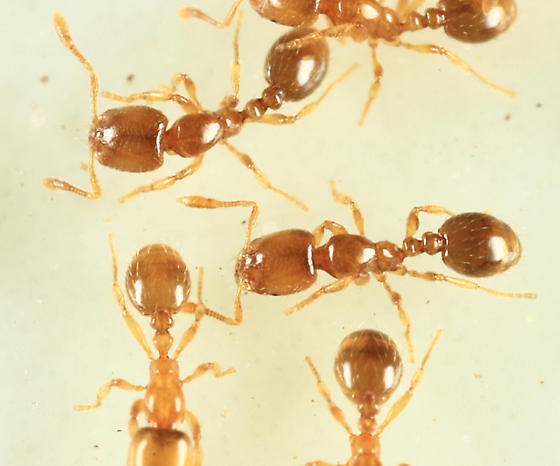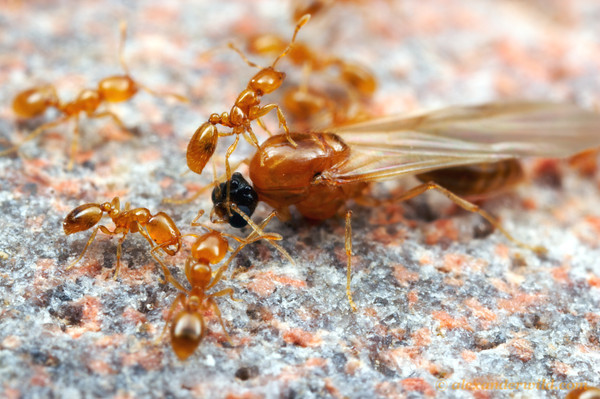Interactions
Solenopsis molesta ants or thief ants get their name
because of their thieving ways off of larger ant colonies. They
steal food from the nests of these other colonies instead
gathering the food for themselves. (Texas
A&M University, 2010). Workers are often observed taking
and carrying food from other species (Hayes,
1920).Some of the nests of the species Solenopsis
molesta are thought to be connected to nests of other ant
species which makes it easier for the thief ants to steal food (Hayes,1920).
A common mistake that is made
when classifying the thief ant is that they are often mistaken
for the Pharoah ant (University of Nebraska,
2013). It is a common occurrence for thief ants to be
confused with other species of ants like this species of
monomorium pharaonis (Pharoah ant) (Hayes,
1920). This species is also known as the red house ant and
they are confused with the thief ants because they have similar
coloration (Hayes, 1920).
Like we have mentioned in our
habitat section, some of the victims of the thief ant
include:
-Cotton boll weevil
- Ladybird beetle
- White- marked tussock moth
- Hessian Fly
In certain situations, a defenseless insect or animal may fall
victim to the Solenopsis molesta (Say) species (Hayes,
1920).
Solenopsis molesta ants interact highly with humans, as
they are pests in the home. Due to their small size, they have
an advantage at getting into hard to reach places in the home,
like cabinets (Hayes,1920). Not only do the thief ants terrorize
humans by scavenging for food in homes, thief ants also eat the
valuable crops of farmers (McColloch
and Hayes, 1916). Thief ants tend to be more detrimental to
the fields of farmers than to the home (Hayes,
1920). The reason that thief ants are so successful at
damaging crops is because of their small size that allows them
to eat crops undiscovered (Hayes, 1920).
One crop that is often damaged by thief ants is corn (Hayes,1920). Find more about
this interesting interaction with farmers in our
nutrition section! However, one
positive interaction with humans and thief ants are that the
thief ants are predators to many other pests that inhabit homes
and damage crops (Hayes, 1920).
Since thief ants eat meat, they are likely to eat dying or
wounded species of insects independent of which specific species
it is (Hayes, 1920).
inhabit homes
and damage crops (Hayes, 1920).
Since thief ants eat meat, they are likely to eat dying or
wounded species of insects independent of which specific species
it is (Hayes, 1920).
While thief ants (Sat) victimize countless other species, the
ants of Solenopsis molesta sometimes fall victim themselves. Their enemies include spiders, horned-toads, and
mites (McColloch and Hayes, 1916).
Birds also often eat thief ants (Hayes,
1920). There are two ant species that have been found to feed on
ants from the species Solenopsis molesta. These species
include Cremastogaster lineolata (Say) and Pheidole
pilifera (McColloch and Hayes, 1916).
Within their own colonies there are less worker thief ants
than there are normally in other ant colonies due to the
presence of multiple queens (Hayes,
1920). Thief ants have also been known for feeding on their
own eggs and larva (Hayes,1920).
